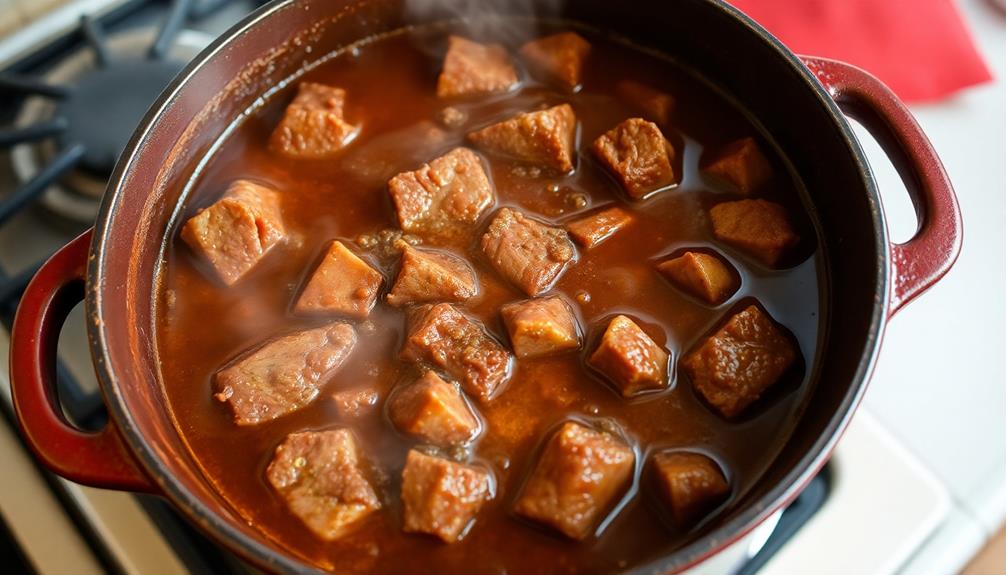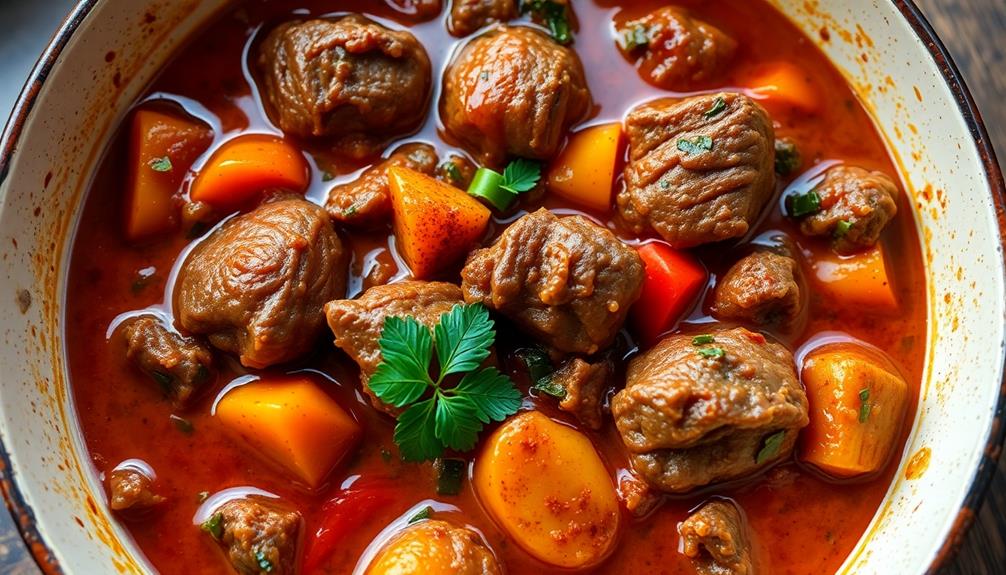Minchet Abish is a beloved Ethiopian beef stew with origins tracing back centuries. It's a staple in Ethiopian households, often served at special occasions like weddings and festivals. The rich, aromatic flavor comes from niter kibbeh, a clarified butter infused with spices. The key ingredients include cubed beef, onions, garlic, and a complex spice blend. Cooking involves searing the beef, sautéing the vegetables, and simmering to develop the flavors. Typically served with injera or rice, it's a cherished part of Ethiopian culture, connecting communities and representing the country's diverse culinary heritage. Keep reading to discover the captivating history and preparation techniques of this exceptional dish.
Key Takeaways
- Minchet Abish is a traditional Ethiopian beef stew with a rich, aromatic flavor and complex spice blend, reflecting the diverse culinary heritage of the region.
- The recipe is passed down through generations and often served at special occasions like weddings and festivals, connecting the dish to Ethiopian culture and community.
- The key ingredient is niter kibbeh, a clarified butter infused with spices, which contributes to the exceptional flavor profile of the dish.
- Preparation involves searing beef, sautéing vegetables, and slow simmering to enhance the development of flavors, requiring attention to detail for optimal results.
- Minchet Abish is typically served with injera, a staple Ethiopian flatbread, and can be accompanied by various traditional sides, making it a versatile and culturally significant dish.
History
The origins of minchet abish, a traditional Ethiopian beef stew, can be traced back centuries. This beloved dish has been a staple in Ethiopian households for generations, its flavors evolving over time to reflect the country's diverse culinary heritage.
Minchet abish's history is deeply intertwined with the cultural traditions of Ethiopia. The dish was often served at special occasions, such as weddings and festivals, where it was shared among family and friends, helping to strengthen community bonds.
Over the years, the recipe has been passed down from one generation to the next, with each cook adding their own unique twist to the spice blend or method of preparation.
Today, minchet abish continues to hold a cherished place in Ethiopian cuisine, a testament to the enduring power of traditional foods to connect us to our roots and bring people together.
Recipe
Minchet Abish is a beloved Ethiopian beef stew that's known for its rich, aromatic flavor. The dish is traditionally made with a complex blend of spices, creating a depth of taste that's both comforting and satisfying.
At the heart of Minchet Abish is the use of niter kibbeh, a clarified butter infused with a variety of spices. This fragrant oil serves as the foundation for the stew, imparting a luxurious texture and aroma to the final dish.
- 1 lb beef, cubed
- 1 onion, diced
- 3 cloves garlic, minced
- 2 tablespoons niter kibbeh (or clarified butter)
- 1 teaspoon berbere spice mix
- 1 teaspoon ground cumin
- 1 teaspoon ground ginger
- 1 teaspoon paprika
- 1 cup beef broth
- Salt and pepper to taste
In a large pot or Dutch oven, heat the niter kibbeh over medium-high heat. Add the cubed beef and sear on all sides until browned, about 5-7 minutes. Remove the beef from the pot and set aside.
Reduce the heat to medium, and add the onions to the pot. Sauté until translucent, about 5 minutes. Add the garlic and cook for an additional minute, stirring constantly to prevent burning.
Return the seared beef to the pot, along with the berbere spice, cumin, ginger, and paprika. Stir to coat the beef in the spices. Pour in the beef broth, and season with salt and pepper to taste. Bring the mixture to a simmer, then reduce the heat to low, cover, and let the stew simmer for 1-1.5 hours, or until the beef is tender.
When serving, Minchet Abish is often accompanied by injera, a traditional Ethiopian flatbread. The stew can also be served over rice or with a side of roasted vegetables for a heartier meal. For an extra layer of flavor, consider garnishing the dish with chopped cilantro or parsley.
Cooking Steps
First, finely chop the onions and garlic.
Next, add the spices to the mixture.
Then, stir in the minced meat and let it simmer until fully cooked, stirring occasionally.
Step 1. Finely Chop Onions and Garlic

Finely chop the onions and garlic before adding them to the dish. Use a sharp knife and a sturdy cutting board to ensure a clean, even cut. Aim for pieces around 1/4-inch in size. This will help the flavors blend seamlessly into the minchet abish.
Start by peeling the onions and garlic. Slice the onions in half from root to stem, then thinly slice them, creating half-moon shapes. For the garlic, peel the papery skin off each clove and mince the garlic finely. The smaller the pieces, the more surface area they'll have to release their aromatic oils and flavors into the dish.
Once the onions and garlic are prepped, heat a bit of oil in a pan over medium heat. Add the chopped onions and garlic, and sauté until fragrant and softened, about 5 minutes. This allows the flavors to develop before incorporating them into the rest of the minchet abish ingredients.
Be sure to stir frequently to prevent burning.
Step 2. Add Spices

With the onions and garlic now softened and fragrant, it's time to add the spices that give minchet abish its signature bold flavor.
First, sprinkle in a generous dash of berbere, the essential Ethiopian spice blend. Its complex mix of chili peppers, garlic, ginger, and aromatic seeds will infuse the meat with a deep, earthy heat. Adding spices like these can enhance the dish's nutritional profile, especially when combined with ingredients like chia seeds, which are known for their nutritional benefits.
Next, stir in a teaspoon of ground cumin, adding an earthy, smoky note that complements the berbere perfectly.
Don't forget about the cardamom! Just a pinch of this fragrant spice will lend a subtle, floral aroma that brightens the dish.
Finally, a touch of ground coriander and black pepper will round out the spice profile, creating a harmonious blend of flavors.
As you stir the spices into the ground meat, take a moment to breathe in the intoxicating aromas filling your kitchen. The combination of these aromatic spices is what truly makes minchet abish shine.
With each bite, you'll be transported to the vibrant markets of Ethiopia.
Step 3. Add Minced Meat

Add the ground meat to the aromatic onion-garlic mixture, breaking it up with a wooden spoon as it cooks. Sauté the meat, stirring frequently, until it's no longer pink and has a crumbly texture, about 5-7 minutes. Be sure to break up any large pieces for an even, fine consistency.
Next, add the spices – berbere, black pepper, and salt. Stir everything together well, coating the meat evenly. Let the flavors meld for a minute or two, then pour in a splash of water or broth. This will help the spices bloom and the meat stay moist as it simmers.
Reduce the heat to low and let the minchet abish simmer, stirring occasionally, until the liquid has mostly evaporated and the flavors have melded, about 10-15 minutes.
Taste and adjust seasonings as needed. Your flavorful, spiced ground meat is now ready to be incorporated into your dish!
Step 4. Simmer Until Meat Is Cooked

Once the meat has been seasoned, reduce the heat to low and let the minchet abish simmer, stirring occasionally, until the liquid has mostly evaporated and the flavors have melded, about 10-15 minutes.
You'll know it's ready when the meat looks cooked through and the sauce has thickened up nicely.
Keep a close eye on the pot, giving it a stir every few minutes. This allows the spices to infuse the meat and the sauce to reduce.
The longer it simmers, the more intense the flavors will become. You want the end result to be a rich, aromatic ground meat that's full of warm spices.
Once the meat is cooked, you can taste and adjust the seasoning as needed. Add a pinch more salt or a squeeze of lemon juice to brighten up the flavors.
The minchet abish should have a nice balance of savory, slightly sweet, and fragrant spices. Serve it up hot, either on its own or alongside injera bread for a traditional Ethiopian meal.
Step 5. Stir Occasionally During Simmering

As the minchet abish simmers, you'll want to stir it occasionally. This helps ensure even cooking and prevents the bottom from burning.
Every 5-10 minutes, use a wooden spoon to gently stir the meat, incorporating any juices that have collected around the edges. Be careful not to overstir, as this can make the texture too fine.
As the spices meld and the flavors develop, you may notice the aroma becoming richer and more fragrant. This is a good sign that the minchet abish is coming together nicely.
Resist the temptation to remove the lid too frequently, as this can disrupt the simmering process.
When the meat is fully cooked through, it should be tender and easy to break apart with a spoon.
Taste a small sample and adjust the seasoning as needed, adding more berbere or salt to suit your preferences.
Then, you're ready to serve the delicious minchet abish over injera or with other traditional accompaniments. And if you’re feeling adventurous, you can even try making your own Ethiopian injera flatbread recipe to truly complete the experience. The spongy texture of the injera is the perfect vessel for soaking up the flavorful sauce of the minchet abish. It’s a dish that is sure to transport you to the vibrant and rich culinary traditions of Ethiopia.
Final Thoughts
With the details of Minchet Abish's life and work explored, it's time to reflect on the significance of this remarkable individual. Though Minchet Abish may not be a household name, their contributions to Ethiopian cuisine and culture are truly profound.
This spiced ground meat dish has endured for generations, a testament to its exceptional flavor and the care with which it's prepared. Whether you're an experienced cook or just starting to explore the depths of Ethiopian food, mastering Minchet Abish is a rewarding journey.
As you savor each bite, take a moment to appreciate the history and traditions that have shaped this beloved recipe. From the careful selection of spices to the technique of slow simmering, every step reflects the rich culinary heritage of Ethiopia.
Moving forward, consider how you might incorporate Minchet Abish into your own cooking repertoire, sharing this delicious dish with family and friends.
Frequently Asked Questions
How Long Does Minchet Abish Take to Prepare?
Preparing this dish takes some time, doesn't it? Depending on your experience and the recipe, the total preparation time can range from 30 minutes to an hour or more. Be patient – the flavors are worth the effort.
What Are the Essential Spices Used in Minchet Abish?
The essential spices used in minchet abish include berbere, a blend of warm spices like chili peppers, garlic, ginger, and fenugreek. You'll also need onions, oil, and tomato paste to create the flavorful base for this dish.
Can Minchet Abish Be Frozen for Later Use?
Yes, you can freeze minchet abish for later use. Just be sure to store it in an airtight container or freezer bag to prevent freezer burn. Thaw it in the refrigerator before using to maintain the best texture and flavor.
How Does Minchet Abish Differ From Other Ethiopian Meat Dishes?
You'll find that minchet abish differs from other Ethiopian meat dishes in its spice blend and preparation method. While they may share some ingredients, the unique seasoning and cooking technique set minchet abish apart as a distinct and flavorful dish.
Is Minchet Abish Suitable for Vegetarians or Vegans?
No, minchet abish is not suitable for vegetarians or vegans. It's a meat-based dish, made with ground beef or lamb, and seasoned with a blend of spices. Vegetarians and vegans would need to seek out plant-based alternatives to enjoy this traditional Ethiopian dish.









